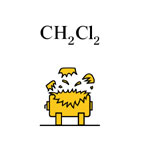| Case Name |
Rupture of the recovery drum of dichloromethane during transportation |
| Pictograph |

|
| Date |
July 3, 2000 |
| Place |
Kawasaki, Kanagawa, Japan |
| Location |
Motor pool |
| Overview |
A metal drum can of 200 liters loaded on a parked truck burst. The contents of the can were waste methylene chloride. One person suffered a chemical burn. The fact that chlorinated solvents might react exothermically when they coexist with aluminum had not been recognized. |
| Incident |
A 200 liter drum can loaded on a parked truck burst. The contents of the can were waste methylene chloride. One person suffered a chemical burn. |
| Processing |
Waste and disposal |
| Substance |
Methylene chloride, Fig2 |
| Type of Accident |
Rupture |
| Sequence |
A total of 200 liters of waste methylene chloride used for cleaning of the parts of a machine were stored in three metal drum cans and left on a truck overnight. The drum cans suddenly burst at midnight, and one person passing by was injured. |
| Cause |
Methylene chloride became a strong acid with chlorine after being repeatedly used for cutting aluminum. In addition, hydrogen was generated by an exothermic reaction, because cutting powders of aluminum were present. The manufacturer of methylene chloride added a stabilizer to prevent a small amount of hydrogen chloride from being generated, in a steady state. However, it becomes impossible to stop the generation of hydrogen chloride simply by adding a stabilizer, if exchange and cleaning are neglected for many years. |
| Countermeasures |
1. Organic solvents used for cleaning of parts have to be filtered to remove chips or metal rust.
2. Whenever gas is generated, it has to be discharged in the safe place. |
| Knowledge Comment |
Aluminum and chlorinated organic substances often react exothermically. Waste treatment causes many accidents. Due to mixing. |
| Background |
The fact that chlorinated solvents become active and sometimes react exothermically when they coexist with aluminum had not been recognized. The manufacturer of methylene chloride is disseminating technical information on how to handle methylene chloride, and instructing users. A detailed manual on the proper use of methylene chloride in metal-cleaning was prepared by the chloro carbon sanitation association. In addition, treatment of wastes including methylene chloride requires related laws and regulations should be observed. These legal regulations and guidance might not have been properly understood. |
| Incidental Discussion |
Users lacked knowledge of handling chemicals. It is necessary to understand the danger. There had been similar accidents in the past. This accident shows the difficulties in enforcing laws and regulations, and in making the basics matters such as following the guidance of manufacturers and business associations known to the end-user level. |
| Reason for Adding to DB |
Typical example of an accident caused due to failure to predict the generation of hazardous materials |
| Scenario |
| Primary Scenario
|
Poor Value Perception, Poor Safety Awareness, Inadequate Risk Recognition, Organizational Problems, Inflexible Management Structure, Insufficient Information Transfer, Usage, Disposal, No Confirmation of Content, Planning and Design, Poor Planning, Poor Planning of Disposal Treating, Bad Event, Chemical Phenomenon, Abnormal Reaction, Secondary Damage, External Damage, Explosion, Bodily Harm, Injury, One of third person injured
|
|
| Sources |
Kawasaki City Fire fighting station, Prevention division, Peace section. Rupture accident of dichloromethane recovery drum. Material of the Kawasaki City Complex safety countermeasure committee (2000)
|
| Physical Damage |
A three-ton truck was damaged. The top lid of the drum flew off and damaged the roofs of two private houses. |
| Multimedia Files |
Fig2.Chemical formula
|
| Field |
Chemicals and Plants
|
| Author |
WAKAKURA, Masahide (Kanagawa Industrial Technology Research Institute)
TAMURA, Masamitsu (Center for Risk Management and Safety Sciences, Yokohama National University)
|